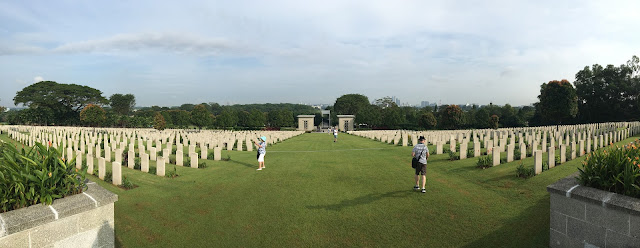A cemetery is usually not top of anybody’s list of places to visit for an excursion, and is even more unlikely to be on the itinerary of visitors to Singapore.
Kranji War Memorial
We boarded our motorcoach and drove to Kranji War Memorial, dedicated to the Allied servicemen and women who died defending Singapore during World War II. The memorial site is multi-ethnic, as nationalities making up the Allied Forces included British, Australian, Canadians, New Zealander, Dutch, South African personnel, and a large number of Indians as well – almost 50% of the names on the memorials are Indian. The memorial is also multi-religious, as Christians, Muslims, Jews, Buddhists and Taoists, Confucians, Hindus, Jains and Sikhs are all commemorated.
The main avenue of the cemetery rises gently from the Stone of Remembrance near the entrance to the Cross of Sacrifice, beyond which are flights of steps leading to a hill-top terrace. On this terrace are four memorials. The largest memorial is the Singapore Memorial with the names of 24,346 soldiers and airmen who died during the campaign in Malaya and Indonesia, or in subsequent captivity, and have no known grave. A register bearing these details is kept by the Commonwealth War Graves Commission. The War Cemetery contains the graves of 4,458 of the fallen. More than 850 graves are of unidentified personnel. The Chinese Memorial in plot 44 is a collective grave for 69 Chinese members of the British Commonwealth Forces.
Note: there weren't restroom facilities at the cemetery, but there were at our next stop.
Old Ford Motor Company
 |
| click images to enlarge |
The old Ford Motor Company factory, was the site of the British surrender to the Japanese in February 1942. The factory was built by Ford Motor Works in October, 1941, and became Ford's first motor car assembly plant in Southeast Asia. Japanese forces invaded Singapore shortly thereafter. During the Malayan Campaign, the factory's modern assembly equipment was used by the Royal Air Force to assemble fighter planes. The National Archives of Singapore, the new custodian of the historical site, has converted the building to house an exhibition gallery and repository called Memories at Old Ford Factory.
Changi
Changi was a POW camp that held over 50,000 British and Australian prisoners of war. Our visit there included Changi Chapel, a reproduction of the 1944 Chapel built by Australian prisoners, and Changi Museum. The museum displays the prisoners' sketches and watercolors, a pair of rail spikes from the notorious Thai-Burma railway where thousands perished, and a quilt made by women inmates.
Note: no photography is allowed inside the museum but you can take as many pictures as you like outside and in the chapel.
Back to the Ship
This look at Singapore history was over as we boarded our motorcoach for the return trip to Sapphire Princess. We encourage you to venture off the beaten path during your voyage. This excursion met our expectations and we would recommend this to anyone interested in history or who had already seen the popular sites in Singapore.
Click on the image to the left for more Blog posts about this trip.
Related Album:
Kranji War Memorial
Former Ford Factory
Changi Museum
Singapore Bay
Additional photos can be found on our Southeast Asia Shutterfly page
View Our Other Shutterfly Share Pages

Sign-up for Exclusive Email Offers
Where have you explored?
Gather your travel and food pics and join us Wednesday night for the latest installment of #FoodTravelChat














